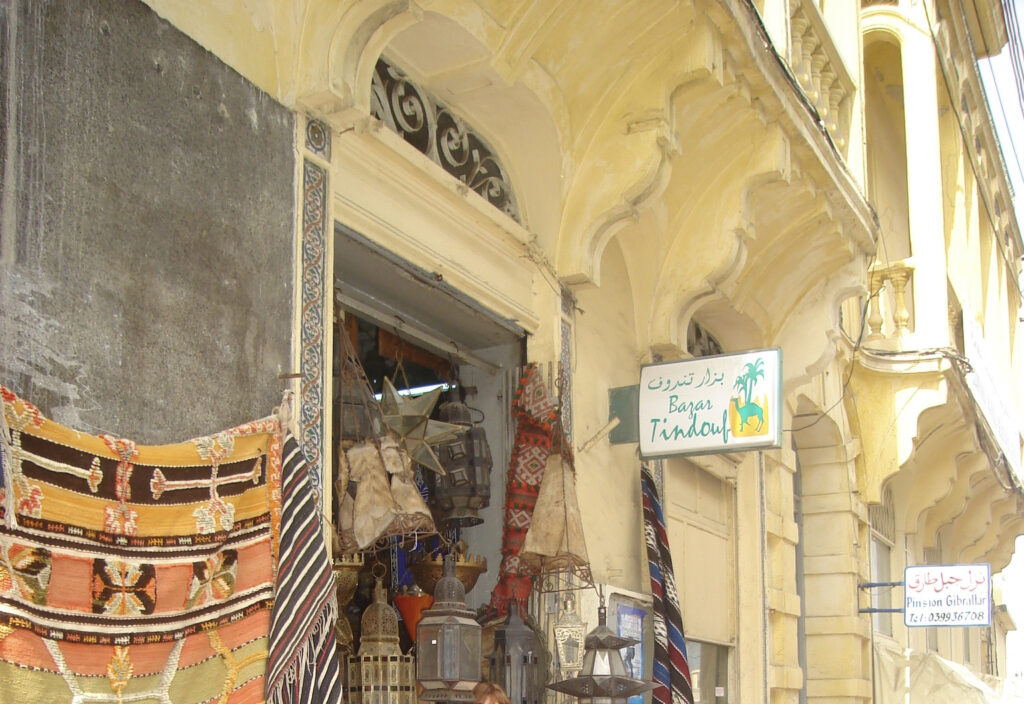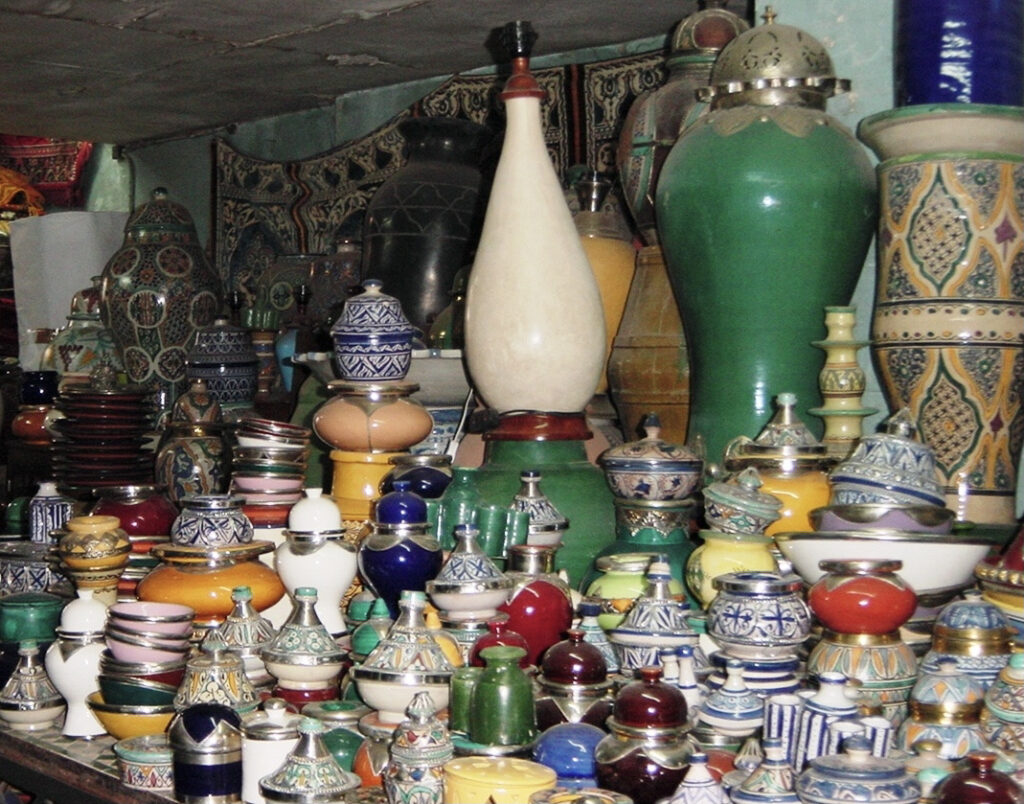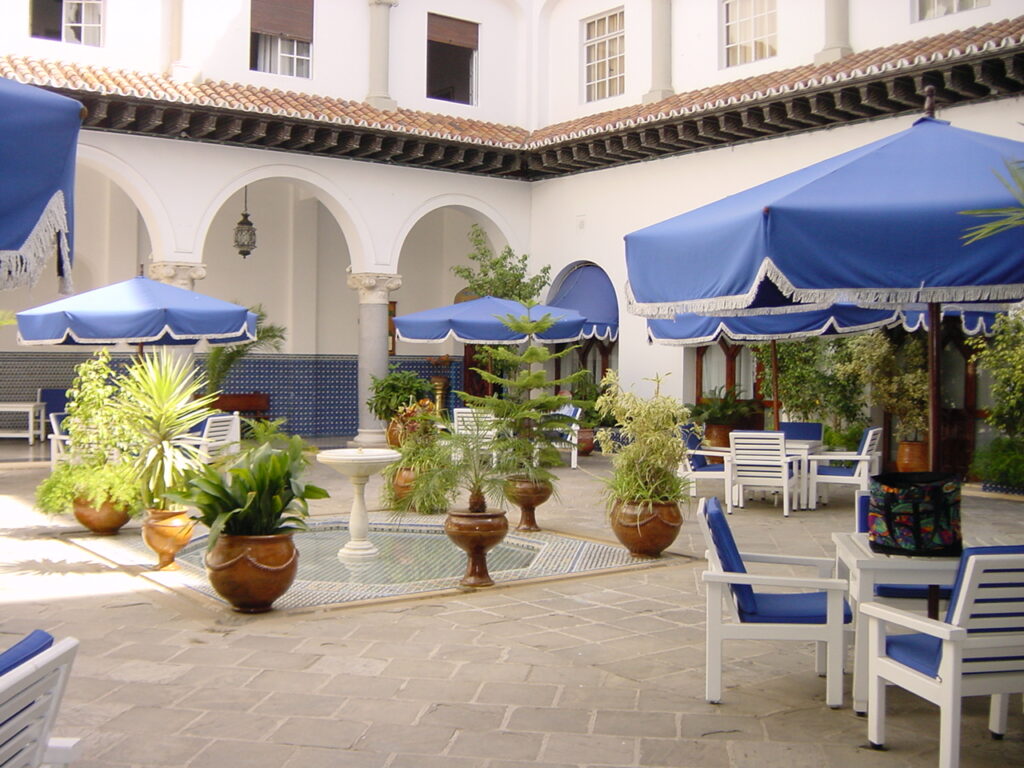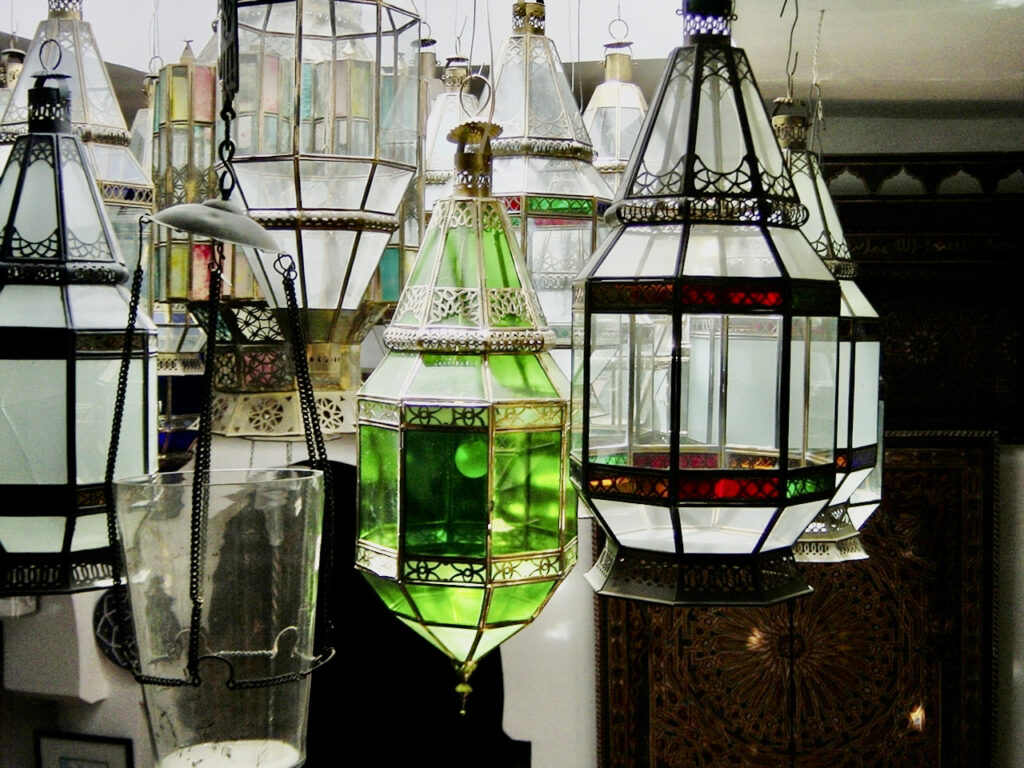I am rushing through the crowded streets, minding my steps as I keep up with the pace. Our first trip to Tangier is turning into a shopping marathon with a guide we nickname ‘Speedy Mustafa.’
Morocco is one hour behind Spanish time, so we arrived before the shops opened. Never mind, we need a break. The hydrofoil boat ride across the Strait of Gibraltar was unsettling. Mint tea and almond cookies on the patio of El Minzah—the five-star hotel on Rue de la Liberté—is a welcome transition.
Deep into Bazaar Bargains
Shopping begins directly across El Minzah. The colorful goods decking Bazaar Tindouf’s door have lured us inside this Ali Baba-like cave for everything Moroccan:
- Heaps of hand-woven kilim rugs
- Rows of hooded djellabas
- Mounds of deflated leather ottomans (called poufs)
- Piles of brass trays
- Loads of copper pots
- Lines of Moorish ginger jars
- Collections of thuja wood boxes adorned with marquetry or tin and camel bones.
The place is packed floor to ceiling, leaving just enough space to mindfully squeeze through until I look up. Kaleidoscopic stained-glass lanterns dangle from the ceiling of a narrow hallway. At the end of it, an old man welds such lamps, in a cavernous alcove next to a decrepit concrete staircase.
Perilous stacks of ceramics line the narrow steps down to a room hoarded with more carpets and glazed ceramic jars. Too tempting to pass, another precarious staircase leads us down to a dirt floor that suddenly hits our sight and senses. In the semi-darkness, the intricate arabesques of the mosaics suddenly seem to churn, and the mustiness is unbreathable. We are in the guts of Tangier, where not a bit of fresh air ever finds its way.
After the expected haggling, I load on one shoulder a bag of lacquered bowls — in jewel tones adorned with tin cut-outs — and on the other, a bag containing two sconces wrapped in Le Journal de Tangier. Back on the street, we get our bearings with a stretched-out map. This is the clue for a man in a white djellaba to introduce himself. We try to communicate between the three of us to decline his service, but Mustafa speaks every language we know. And he would also carry our bags.
Around the Shops in a Few Hours
The marathon begins on the way to the medina—the 14th-century walled part of the city. An outdoor market, evidently the daily errand of Moroccan housewives, rushes by. We speed-walk to keep up with Mustafa through stalls of produce and mounds of ‘tangerines,’ so named in Europe because they came from Tangier.
Soon after and already out of breath, we holler Mustafa, so he’ll wait as we rush into a kitchenware store. Dishes with pointed lids—the safe kind to cook tagines—plus festive tea glasses then join the load on his arms.
In the hustle and bustle of the medina, Mustafa seems to keep his distance, even darting to the opposite curb. “Why?” we ask. As an ‘independent’ guide, he gets in trouble with the ‘official’ ones. And occasionally with the police. The tourist grapevine is full of stories of those official but despotic guides. We feel lucky to have Mustafa, even if he keeps disappearing.
After Mustafa checks again the list of shops we selected, we start hopping over curbs to avoid running sewage. Then we arrive at Majid’s Antiques. There, dazzling displays of vintage clothing, embroidered fabrics, painted wooden chests, and remarkable Berber jewelry take away what’s left of our breath.
Majid is a kind-mannered man accustomed to Western designers and celebrities. He entrusts us to Mustafa for lunch at El Andaluz: a hole-in-the-wall eatery with four tables, a portable barbecue, and a two-burner stove on the doorstep, plus a small wall-hung sink (to ‘purify’ one’s hands). The only women there, we feel welcome and safe. And while we have lunch, Mustafa will answer the call for prayer.
From Perfume to Pigeon Pie
Back on the shopping racing track, we frown at the closed door of Medini’s Oriental Perfume Essences. But only until Mustafa finds the chemist, who re-opens the shop for us. Handwritten labels on the vials aligned on wooden shelves reveal delightful fragrances: jasmine, verbena, santal, patchouli, citrus blend, and the costliest of all, the ‘absolute of rose.’ We leave the store with essences, natural soap, and glass tubes of liquid amber and musk—sweet, fresh, heavenly.
The next stop is a Berber pharmacy where we buy argan oil. Endemic in Southwestern Morocco, it is valued for its nutritive and medicinal properties. It’s also a beauty product praised by Moroccan women. Beware, though: it quickly becomes rancid.
Our time is running short if we don’t want to miss our passage back to Spain. We must still find Mouatamid, the pastry shop where we pre-ordered bisteeyas—the traditional pigeon pies loaded with hearty ingredients.
Then a bit of a spat happened, in Arabic, between Mustafa and a seller of baskets. We needed some for our upcoming pasty load. Mustafa won’t let us pay ‘that much’ for the palm-leaf woven kind. Shortly after, a begrudged Mustafa elbows that basket vendor on a crowded street.
As we rush out of the souks, ambulant merchants chase the last of our cash. It’s time to part with Mustafa and pay for his service in this city where unemployment is high. After furtively pocketing the money, he thanks us and hails a taxi.
Time is ticking, the driver keeps the engine running while we run into the pastry shop. A flabbergasting misunderstanding then yields twelve instead of six boxes of pigeon pies, large instead of small, and awaiting our pick-up. ‘They can be frozen,’ I hear someone say. I regretfully eye the gazelle’s horns cookies.
It’s past midnight when, exhausted by the long day, we retrieve bags and baskets from the car. Oil has dripped from the pigeon pies onto the mat of the trunk. Let’s ‘freeze the pies’ and clean up tomorrow… For months thereafter began a new tradition at our house in Spain: Serve our guests a heaping slice of that mind-boggling, crumbling sweet and savory pastry.
More stories about Morocco:
Morocco: Vintage Textiles and Jewelry
First published 2012 on Buckettriper.com – edited 2024






